« October 2014 | Main | December 2014 »
November 30, 2014
Coffee Break

Guinn "Big Boy" Williams and Alfonso Bedoya in Man in the Saddle (Andre de Toth - 1951)
Posted by Peter Nellhaus at 09:30 AM
November 27, 2014
Happy Thanksgiving

Posted by Peter Nellhaus at 08:45 AM
November 25, 2014
The Conformist

Il Conformista
Bernardo Bertolucci - 1970
Raro Video BD Region A
Is it possible that I saw a slightly different version of The Conformist back in March 1971, prior to its New York City opening? I am certain that there were scenes of Pierre Clementi not simply describing his "Madame Butterfly" robe, but wearing it onscreen. Maybe I imagined Clementi's description so vividly that I've been certain for all these years, decades really, that the two scenes of Lino, the chauffeur, have him wearing the very feminine robe.
One shot that there is no question about is of Marcello, the title character, going to an official fascist government office, a huge, empty space. A large bust of Mussulini's head and a statue of an eagle pass each other across the frame. There was something surreal about that shot that has stayed with me.
There is also the low angle full shot of Marcello and his mother, shot from the ground tilting upwards, Marcello helping his mother into a car, the ground covered with golden brown leaves blowing. It is a shot that takes my breath away. I'm not the only one who has responded to that specific shot as it is briefly discussed in the supplement that looks at the history of the making of The Conformist.
And then there is the scene of Dominique Sanda and Stefania Sandrelli dancing together, what I like to refer to as the "First Tango in Paris". I was nineteen when I saw The Conformist for the first time, and that dance scene was, for me, one of the the most erotic things I had ever seen.
That one scene with Jean-Louis Trintignant walking along the sidewalk with the tilted angles? It wasn't until much later that I understood that this visual bit was taken from The Third Man, a film that featured Alida Valli, who appeared in Bertolucci's previous film, The Spider's Stratagem.
I can't be the only one who thinks that the scene of the killing of the professor not only is evocative of Shakespeare's Julius Caesar, but Orson Welles' modern dress stage production, with its black shirted Romans, from 1937, a year before the main narrative of The Conformist takes place?
The other most famous film adapted from a novel by Alberto Moravia is Godard's Contempt. I read the novel, A Ghost at Noon as well as Moravia's novel which provided the basis for Bertolucci's film. Trust me on this: both films are better than the novels. Which brings me to both films have Georges Delerue providing the music. Both scores convey the sense of romantic yearning, although there is also a musical theme usually played in association with the fascist agent who keeps tabs on Marcello, a theme that owes something to Kurt Weill in his collaborations with Bertolt Brecht. There is also a little joke in the film with the announcement of dance music composed by "Maestro Delelrue". There is also the revelation that Bertolucci had originally approached Contempt star Brigitte Bardot for the part taken by Dominique Sanda.
The Conformist was not my introduction to Bertolucci. I had seen Before the Revolution thanks to the recommendation of a fellow film student. What seemed revelatory at the time has, in retrospect, also been a work that indicated some of what was to follow, especially Last Tango in Paris and 1900. Much of the imagery still remains powerful more than forty years later.
Posted by Peter Nellhaus at 07:06 AM
November 24, 2014
Touch of the Light

Ni guang fei xiang
Chang Jung-chi - 2012
Well Go USA Entertainment Region 1 DVD
Like the use of color in the film, any drama in Touch of the Light is muted. Based on part of the life of blind pianist Huang Yu-siang, there are no crushing lows or overly triumphant highs. There is an ebb and flow of small obstacles and modest victories, giving the story some more of a sense of reality.
Chang and Huang knew each other at the university they were attending in Taipei. A documentary short made by Chang of Huang was seen by Wong Kar-wai who encouraged Chang to make a feature. The film is about Huang's first year away from home, with both the challenge of being the first blind piano student in Taiwan's university system, as well as learning how to live somewhat independently. The story is given a dramatic framework by cross-cutting with a story about a young woman, Jie, who has all but given up on her dreams of being a professional dancer, slogging through life working at a juice stand. The blind pianist and the aspiring dancer meet when Huang is spotted having difficulties crossing a busy intersection. While there is no romance, at least in the traditional sense, the low-wattage sparks between Huang and actress Sandrine Pinna seem to have been enough to help the film's commercial viability in Asia.

From the little in English that I've been able to read, the inclusion of Jie was not the only fictionalized part of Huang's life as portrayed in the film. What does seem truthful is Huang's reluctance to participate in competitions, where the students demonstrate their musical abilities in the form of small ensembles. That reluctance stems from both the assumption stated by some that have Huang winning as a kind of compensation for being, as well as the self-doubts created by overhearing that assumption expressed. Not stated in the film, but known to that Taiwanese audience, is that Huang has validated himself as a professional musician.
Chang does makes some interesting choices visually, using out of focus shots to convey Huang's visual impairment, as well as use of sound which for Huang was highly developed, be it the tinkling of ice, the rumbling of motors, or scratching the surface of a wall. Quick shots of hands and legs emphasis life as a tactile experience. One humorous scene has Huang playing a percussive version of "Flight of the Bumblebee" by tapping against his mouth and teeth. Huang also contributed to the film's score. Someone in Taiwan was observant of Hollywood's habit of awarding Oscars to movies about the physically challenged, with Touch of the Light offered as the Foreign Language Film submission last year.

Posted by Peter Nellhaus at 07:35 AM
November 22, 2014
Starz Denver Film Festival 2014 - Kumiko, the Treasure Hunter
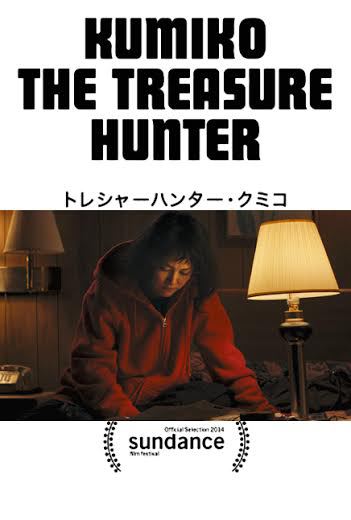
David Zellner - 2014
Amplify
Though Alexander Payne's relation to this film was as Executive Producer, Kumiko might be seen as something of a companion piece to his own Nebraska. Both are road trip films with people certain of the prize at the end of their destination, no matter how unrealistic it may seem, no matter what doubts others express, no matter what obstacles seem to get in the way. As humorous as the premise may seem, about a Japanese woman convinced of the reality of a scene of buried money in the Coen Brothers' Fargo, this is not played for laughs, although there are some moments of humor.
Rinko Kukuchi's Kumiko is an aging "office lady" in Tokyo. By aging, she is twenty-nine and single when most women in that position have left by twenty-five and are married. The lowest in the pecking order, Kumiko is the one to get tea for the boss and go on errands on his behalf. You can tell by looking at her face, and disheveled appearance, that life has beaten her up. Kumiko would rather be alone in her cramped apartment with her pet rabbit, Bunzo, than be out in the world.
The discovery of a worn VHS tape of Fargo with its announcement at the beginning that the film is a true story are all Kumiko needs to inspire her quest which brings her to snowy Minnesota, with her collection of maps. When Kumiko arrives in Minneapolis, the 1965 song, "Dream", by Pete Drake is on the soundtrack. The song itself, with Drake's "talking" steel guitar, sounds like something from another world, metallic and distorted. But there are parts of the movie that suggested to me that Kumiko's life was weaving in and out of dreams, without any kinds of the usual visual cues that announce themselves, but with certain details that seem out of place.
When Kumiko's boss has, what is in his mind, a friendly discussion about Kumiko's career, the options presented are the most traditional choices. Kumiko responds about making her own path. In a way that's as indirect as Kumiko's path, the film is about both dreams and tenacity. Where it lends itself also to being understood as some kind of fairy tale is in Kumiko's identifiable red hooded jacket. There is no big, bad wolf, although there is one possibly wild dog.
Where there is humor, it is often found in static camera shots, with Kikuchi's actions within the frame, simply observing her, and letting the action speak for itself. The observational humor also extends to some cultural misunderstandings with a couple of Minnesotans trying to help Kumiko. And as wry as these moments are, it gives way to a smile at a satisfying ending.
Posted by Peter Nellhaus at 06:48 AM
November 21, 2014
Starz Denver Film Festival 2014 - The Patent Wars

Hannah Leonie Prinzler - 2014
Filmkantine
Another documentary that's a first person journey, though without the sense of humor of, say, Michael Moore or Morgan Spurlock. From the discovery that a human gene can be patented, and what that means, to travels from Germany, to the U.S. and India.
The history of patents begins with inventions - the lightbulb, the telephone, and somehow evolved into bits and pieces of nature, genes and seeds being the most common. The impact of a particular gene patented meant that a woman with a certain kind of cancer can only have a test available by the one company that has patented the gene, and if not covered by her insurance company, would have to pay a hefty fee for that test.
In India, there is the fight not only to farm certain kinds of rice, but also inexpensive ways to employ technology to do farming. There are also visits to those organizations that attempt to work on behalf of the common good, be it in terms of making information available, or in some way circumventing corporate greed.
A bit closer to home, James Dyson, he of the vacuum cleaners that carry his name, discusses the extraordinary amount of money he spent to patent his devices, as well as money spent on a patent infringement by Hoover.
Thought provoking stuff, to be sure. But there were times when I would have like some of the Teutonic sternness to have be modified with a little bit of Yankee humor.
Posted by Peter Nellhaus at 06:35 AM
November 20, 2014
Starz Denver Film Festival 2014 - Norway
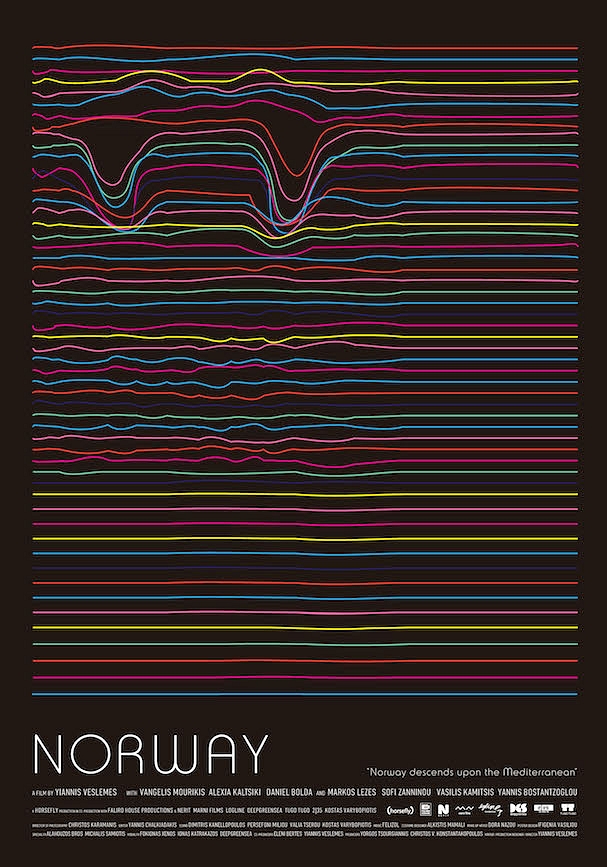
Norviyia
Yiannis Veslemes - 2014
Horsefly Productions
If you only have time in your life to see one disco vampire movie in this lifetime, Norway is the one to see.
I'm pretty certain that not all Greek films are as idiosyncratic as the ones lately making the festival circuit and the occasional stateside release. Norway exists in a hazy space somewhere between Dogtooth and its offsprings, and the spare change fantasies of Edgar G. Ulmer. There's no denying that the opening travel of Zano, the vampire, is composed of shots of a model train set, or that Athens is first seen as a series of cutout skyscrapers, but that is part of the charm.
With his blond shag haircut and droopy mustache, Zano looks like an aging rocker. Rather than wait for the elusive Jimmy the Gravedigger, Zano shows up at the Disco Zardoz, a neighborhood dive really, where he begins one very long night, lead by the dark, attractive Alice to an unexpected place.
That the film takes place in a city called Athens is as close to reality as it gets here. Zano finds another vampire, a cadaver thin junkie, who has forsaken blood for heroin. Characters bleed yellow or blue. Zano is taken to do what is described as a job, to bestow eternal life on one very old man, but even vampires, or at least this one, has standards.
Even though Zano mentions that the story takes place in 1984, the year is no more literal than Athens, mostly a collection of empty buildings and a nightlife of punks, drunks, and the down and out. As Zano, Vangelis Mourikis hardly looks like the classic vampire, not thin, and certainly not elegant in his manners. And unlike the vampires that stand still and glower, Zano just wants to boogie, ideally with any reasonably attractive girl that might be available. Even when there is no music, Zano can't stop bopping away. Call it "Saturday Night Fever Dream".
Veslemes is smart enough to not stretch things out further than needed. Even at less than seventy-five minutes, this nighttime journey is on the leisurely side. While there is some adherence to vampire lore, genre purists might be taken aback when Zano has a taste of soup spiced with garlic. This is not your daddy's vampire movie, although between giving the vampire legend new twists with films like The Lost Boys, or giving an old chestnut new life, with rock soundtracks for Nosferatu provides some kind of context for the kind of liberties Veslemes takes with Norway. Suffice to say this is one strange, little film.
Posted by Peter Nellhaus at 06:17 AM
November 19, 2014
Starz Denver Film Festival 2014 - Man from Reno
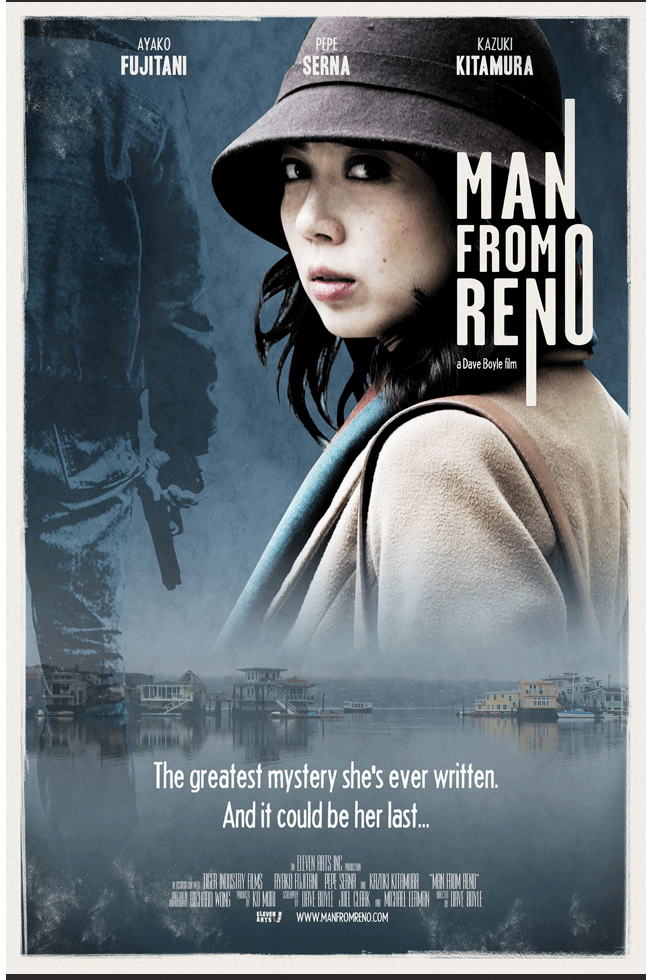
Dave Boyle - 2014
Eleven Arts
It's an American independent film, and not one of those so-called indies from a studio. Most of the dialogue is in Japanese. As far as genres go, I think it safe to describe this as neo-noir. And it works.
Maybe one of the things in favor of Man from Reno is that it takes just enough visual and narrative elements from classic noir without any obvious kinds of homages that some filmmakers employ, the kind that tell the "knowing" film viewer that the director has seen Out of the Past, Detour or has read the collected works of Cornell Woolrich. On the other hand, I would be surprised if Dave Boyle and co-writers Joel Clark and Michael Lerman weren't familiar with the films and writers often cited.
Still, it is probably fitting that much of the story takes place in San Francisco, home of The Maltese Falcon. San Francisco alternates with the fictional San Marco County, the kind of place past by if you're driving between the bay area and Nevada. Sheriff Paul Del Moral is driving on an empty road, in fog so thick you can barely see anything in front of your nose. After checking out what appears to be an abandoned town car, Del Moral accidentally strikes down a man walking on the road. The man is taken to the local hospital, only to disappear. In the meantime, Japanese mystery writer, Aki, tiring of her popular series of novels about Inspector Tanabe, does her own disappearing act, leaving Tokyo for San Francisco, meeting old friends, and plotting the end of her fictional creation. Del Moral and Aki are connected by a series of initially unrelated events, with Aki finding herself as a protagonist in her own real life mystery. Among the things to ponder is a suitcase with a head . . . of lettuce.
As the film progresses, it becomes a story of multiple hidden identities, eventually veering into an unexpected ending. Would the film have worked as well had many of the characters not been Japanese, or had everyone speaking English? I can't answer that except that we would have missed one funny scene with Aki and a friend discussing how Americans mispronounce Japanese words (and yeah, I'm guilty). What is refreshing is to have a film with the kind of racial and ethnic mix usually not seen in most American films.
It is because of the casting that Man from Reno features actors who would more typically be relegated to supporting roles, especially Pepe Serna as Del Moral. Ayako Fujitani plays Aki, the thirty-something writer fleeing from celebrity into a trap she could never imagine. Kazuki Kitamura portrays Aki's mysterious lover, and I had forgotten that I had seen him previously in the two Thermae Romae films. What is also nice is that Boyle's characters seem reasonably realistic, when too many filmmakers confuse quirkiness or eccentricities as originality. Man from Reno has rightly proven itself to be a crowd pleaser in previous film festivals, and is well worth seeking out.
Posted by Peter Nellhaus at 06:48 AM
November 18, 2014
Starz Denver Film Festival 2014 - Thou wast Mild and Lovely

Josephine Decker - 2014
Cinelicious Pics
Considering the hubbub over Christopher Nolan's sound mix for Interstellar, anyone who was upset by that film's use of occasionally inaudible dialogue would best avoid Josephine Decker's work here. As for something resembling a straightforward narrative, you won't find that here either, as some bits and pieces of information are left out, especially in the ending, which producer Laura Heberton assured the festival audience, was deliberately ambiguous.
And I felt like I knew less about the main character, a young woman named Sarah, when the film ended. Her voiceover narration mentions a lover, no name, or even gender, is mentioned. The camera wanders around the small farm Sarah calls home, with a close up of a threatening dog. Sarah appears to be in her late teens Tossing a headless chicken with an older, bearded man, it turns out that the two are father and daughter. A man named Akin is the hired hand, although the father, Jeremiah, doesn't have much faith in his abilities to do the work. Not much about Akin is revealed, although it is indicated that he failed in some kind of venture involving beer hops. Although it is mentioned that Akin is married, he can't keep himself from spying on Sarah through a partially opened door, wearing just her bra and panties.
But what is really onscreen are hints of a story. Whatever tension is between Sarah and Jeremiah is ratcheted by Akin's presence. There is a mention of previous hired hands having dissatisfied Jeremiah, making one wonder if anything more suspicious had happened in the past. As the film progresses, Decker demands that the viewer fill in the blanks. Those seeking fully explanations will no doubt be frustrated, as the film concluded with as many questions as answers.
The discordant music by Mary Herron and Jeff Young reminded me of the kind of music associated with the Kronos Quartet, music composed by Penderecki being a more famous example. Out of left field is a brief moment of Betty Hutton singing "Murder, He Says", from the movie of the same name. And the song is a giveaway to what will later happen. But I would also like to think that George Marshall's comedy with naive Fred MacMurray stumbling upon the farm belonging to a lunatic family with a comely daughter provided some of the inspiration as much as the oft-stated, and more culturally respectable East of Eden. More accurately, thou wast wild and lovely.
Posted by Peter Nellhaus at 06:55 AM
November 17, 2014
Starz Denver Film Festival 2014 - An Evening with Lawrence Jordan

"Larry Jordan is a determined explorer who has changed the direction of his film work a number of times. Starting with psychodramas, he has gone through very personal family-oriented films and on to highly accomplished animated collages, notably Duo Concertantes"
Sheldon Renan - from An Introduction to the American Underground Film (1967)
And maybe I'm alone on this, but I wish that the program of Jordan's films, presented last night at the Sie Film Center, had offered a broader scope of his work. The only break from the animated collages was the inclusion of Water Light, made from three rolls of 16mm Kodachrome shot during Jordan's time in the Merchant Marines, around 1953, of his ship following a storm.
Jordan and Stan Brakhage were friends from their time at Denver's South High School. It was fitting that Jordan be a recipient of the Starz Film Festival "Stan Brakhage Vision Award".
The films, including a restored version of Our Lady of the Sphere showed something of an evolution of Jordan's work. Basically using a visual non sequitur of a rolling ball, or circus artistes appearing in seemingly at random in Victorian era engravings, Jordan would take some of the same visual ideas and use them in a variety of artwork, Persian or Indian, and add more cut outs, with ever increasing complexity.
A light Q & A session followed the screening, with Jordan mentioning the visual influences of Max Ernst and Georges Melies, and the pride of having Our Lady of the Sphere added to the National Film Registry in 2010. Jordan also mentioned that even with recurring visual motifs, there was no intended meaning, and everything was up to the viewer's interpretation.
Most of the films shown were made after Renan's brief portrait of Jordan was published. One might write things off to a colder than normal November here in Denver, but it struck me that at the time Renan's book was published, there was a much more active interest in non-narrative films almost fifty years ago, even from a casual audience. The last time I saw any of these films was essentially in a classroom in New York City, almost forty years ago. I liked the idea of seeing this work on a bigger screen with more comfortable seating, especially the complete Solar Sight trilogy.
Posted by Peter Nellhaus at 06:15 AM
November 16, 2014
Starz Denver Film Festival 2014 - Alleluia

Fabrice du Welz - 2014
Music Box Films
Following Leonard Kastle, Arturo Ripstein and Todd Robinson, Fabrice du Welz takes a whack at the story of the Lonely Hearts Killers. The basic story is the same, about the seductive sleaze and the woman who first is his victim of a con, who then becomes his partner in crime. The story is updated and moved to contemporary France and Belgium.
What du Welz takes from the facts about Raymond Fernandez, renamed Michel in the film, is his obsession with some kind of black magic. Prior to getting involved with any women, an invocation is made to the elements for his success in luring the woman for his next con. There is also a greater emphasis on the head injury, with Michel being more psychologically and physically fragile than his cinematic predecessors.
What du Welz does, making this film a departure from the previous films, is the periodic detour from a straight forward narrative. This is most clear in a scene where Michel and Gloria, the Martha Beck proxy, engage in some kind of primal dance outside, by a fire. The jungle, real or as metaphor doesn't seem too far away in du Welz's films. In his previous film, Vinyan a couple search for their missing child in the jungles of Thailand, only to be abandoned to the elements, and a tribe of young boys. Jungle fantasies also are played out with a viewing of The African Queen, and Michel and Gloria posing as missionaries recently returned from a small church in Africa, under siege from rebels.
More than the earlier films about the "Lonely Hearts Killers", is the emphasis on the relationship between Michel and Gloria. One bit of irony has Gloria telling Michel to watch out for "bad people". Du Welz also has Gloria break out into song following the murder of the first victim, a scene that might recall Sweeney Todd, but with a grislier ending.
In an interview, du Welz discusses the actual events as a starting off point. What is of interest to du Welz, and what would be of interest to the viewer than, is how this repeated story is told. Some of the film comes close to what use to be called experimental filmmaking, providing a visual reference to the mental breakdown of both characters.
The final scene is a long shot of Michel and Gloria going to a movie theater. The dominant color in the shot is red. The two inquire as to whether the movie is a love story, presumably one that is does not frequently tilt towards Michel and Gloria's tendencies of self-destruction. The use of color might by visual tip of the hat to Arturo Ripstein's film about Beck and Fernandez, titled Deep Crimson. It may be a movie theater we see in the distance, but it looks like it could well be the entrance to hell.
Posted by Peter Nellhaus at 07:32 AM
November 15, 2014
Starz Denver Film Festival 2014 - Viva la Liberta

Roberto Ando - 2013
Distrib Films
I don't know how familiar Roberto Ando is with Being There, either the novel or the film, or if Toni Servillo, playing two dissimilar twin brothers was in any way inspired by Peter Sellers, but there are some moments where the two films share a similar spirit. Ando's film, taken from his own novel, is about a politician, Enrico, running for national office, last in the polls, disappearing from Rome. The politician's aide chances upon the twin brother, Giovanni, who unlike Enrico, is unguarded about what he says to anyone. Talked into pretending to be the politician, a connection is made with the public, vaulting the pretend Enrico as the projected winner.
The similarity to Being There is with Enrico, mentioned a couple of times as being a "madman", being, if not an idiot savant, one whose frankness of speech and various literary references, energizes his political party, as well as the crowds. There is also Servillo's ability to portray two different men in such a way that initially with subtle facial expressions, the brothers are individually identifiable.
Servillo's real performance is with his legs. At one point, Giovanni is followed by the aide, Andrea. Giovanni walks in such a way as to always block Andrea, pointing his feet in different directions. Later, when impersonating Enrico, Andrea spies on Giovanni, barefoot, dancing with a female politician whom he was presumably set to meet for a serious discussion. Giovanni surprises Andrea by taking him to a dance studio where he demonstrates the ability to rock out with the litheness of a much younger man. Where Viva la Liberta especially shines is in Toni Servillo's fancy footwork.
Viva la Liberta won two David di Donatello Awards last year, the Italian equivalent to the Oscars. Ando, with Angelo Pasquini, won for Best Screenplay. Valerio Mastandrea won Best Supporting Actor for his performance as the often harried aide, Andrea, and ironically also won that year for Best Actor on another film, beating out the deservedly nominated Servillo.
Ando discussed some of his influences in making Viva la Liberta in this interview.
That details about Italian politics might not be known should not in any way dissuade potential viewers, as Servillo's performance is what makes this film worth seeing. Especially as Servillo is better known in the U.S. for the more serious The Great Beauty and Dormant Beauty, his performance comes as something of a delightful surprise.
Posted by Peter Nellhaus at 07:01 AM
November 14, 2014
Starz Denver Film Festival 2014 - August Winds

Ventos de Agosto
Gabriel Mascaro - 2014
FiGa Films
There is a fantastic shot, or at least fantastic for those who pay attention to what is happening within the frame. On each side of the frame is an extremely tall palm tree. Nothing seems to be happening other than the trees swaying in the breeze. The shot is from a distance, so it take a couple moments to realize that two men are climbing each of the trees. The climb seems effortless based on how quickly they raise themselves to the top. Because they are small figures in the shot, their agility can only be imagined.
Most of the shots within August Winds are done with a fixed camera, forcing the viewer to take in all that is within the frame, observing the motion within the shot. In the same way, the viewer has to actively put together some of the narrative pieces, mostly about a man and a woman, and a small village near the northeastern coast of Brazil.
Shirley and Jeison work collecting cocoanuts for a never seen businessman. While Jeison dives among the coral reefs for calamari to sell, Shirley sunbathes on a small boat, listening to hard rock, in one scene dowsing her body with Coca-cola. A stranger appears with equipment to record the sounds of the wind. A newscast discusses how the coastal area is eroding. What we are watching may well be the eroding of a way of life in a village so small and remote, it has no name.
There is the sense that one can't fight nature, there are only stopgap measures or total surrender. An attempt to block water from rising fails as it floods the floor of the house belonging to Jeison's father. A very low, makeshift wall, hardly six inches high, does nothing to hold the tide that will eventually cover a coastal graveyard.
This is the first narrative feature by Gabriel Mascaro, following a series of documentaries. In a new interview, Mascaro discussed the making of the film, as well as some of his artistic influences.
Lest one assumes that a film frequently described as meditative is also a somber viewing experience, there is wry humor with Jeison trying to negotiate the discovery of a dead body with what passes for legal authority in the closest city. While we only see a couple of the houses, Jeison patiently explains where his nameless village is located, and that there are no street names or numbers.
Even with the knowledge that this village and its way of life may soon disappear, Mascaro also celebrates nature with Shirley and Jeison's matter of fact nudity, the billowing, gray clouds, the waves on the beach, and mostly the wind through the trees.
Posted by Peter Nellhaus at 06:58 AM
November 13, 2014
Starz Denver Film Festival 2014 - Castanha

Davi Pretto - 2014
Tokyo Filmes
I didn't do much reading about this Brazilian film prior to watching it. The result was being caught by surprise that the title role is played by Joao Carlos Castanha. The film is not not a documentary, though from what I've gleaned, there are some similarities between the screen character and the man in real life.
While the most publicized aspect of Castanha in this film is his occasional work as an aging drag hostess in a gay bar, that's only part of the film. Castanha's mother, whom he shares a small apartment with, played by his real mother, euphemistically calls it "night work", always staying up late, waiting for her son to come home.
Castanha also has acting gigs, a small character part in a film, more frequent work in theater. Perhaps not the most erudite cinephile, Castanha talks about sitting in a theater to see Bugsy Malone several times, while a conversation with younger friend mentions Danny the Dog (Unleashed).
Mostly, Castanha is a meditation about growing old and alone. Whatever is said, and not said, the real story is in the deep lines of Castanha's face, his constantly disheveled appearance, and his occasional wheezing. His mother asks if the son can do something other than the "night work", when there is the unstated acknowledgment that there is not much of a future. The bleakness of that future might well be indicated when Castanha takes his drag act to a nightclub in a rundown, virtually empty, beach town.
While Joao Castanha is an experienced actor, this was the first acting role for his mother, Celina, playing herself. In interviews about the film, Davi Pretto has discussed the mix between documentary and fiction. There are a couple moments in stage roles where Castanha's lines could well be autobiographical. Castanha's drag performances are usually at a dive called Club Mixx, but the real mix here is the blend of reality, fiction and fantasy.
Posted by Peter Nellhaus at 07:34 AM
November 12, 2014
Starz Denver Film Festival 2014 - Killers

Kirazu
Mo Brothers - 2014
Well Go USA Entertainment
Would Michael Powell be shocked if he saw Killers? Would he be upset by the cultural changes that have taken place since Peeping Tom was released in 1960? The connections I'm making with the Mo Brothers' film is twofold. The killers in their film document their murders with digital cameras, with the camera focusing on the victim. While the violence is much more graphic in the newer film, both Powell and the Mo Brothers (Kimo Stamboel and Timo Tjahjanto) work is to be admired for the formal beauty, the impeccable cinematography. The big shift is that in Powell's film, the films of the murders are for personal viewing, while the Mo Brothers characters live at a time when previously private acts are shared over the internet.
Some might argue whether this an exploitation movie with the visual qualities found in a Terrence Malick film, or a blood soaked art film. And if so, would those who profess a love of cinema as an art form run away if not shielding their eyes? Would the mavens of slasher films not notice how every shot is carefully composed? I can imagine the conundrum of some viewers of Killers being similar to that of the critics who took a serious look at Ruggero Deodato's Cannibal Holocaust, confused as how a movie full of stomach churning images could be so well made. A close up of a single white rose, splattered with blood, sums up the seemingly contradictory impulses at work here.
The film alternates between Tokyo and Jakarta. Nomura is a serial killer, wealthy enough to own a large home in a remote area, with a room designed for torture and murder. His onscreen identity is hidden with a large, white mask. One of his videos is seen by Bayu, a journalist eking out a living following his attempt to reveal the corruption of a high level politician, curiously named Dharma. The two men chat online, with Nomura encouraging Bayu to act upon his anger. While Bayu's murders are loosely based on a sense of righteousness, Nomura's motivations are hazy, without the emotional involvement that spurs Bayu, although he does periodically get caught up in memories of his dead sister.
In addition to the differing reasons for killing, there are the differences in how Nomura and Bayu live. While Bayu lives in a small house crammed with photos on the walls, books and files, Nomura's very large house is spartan, with unsuspecting guests entering a gray fortress void of any furniture or personal belongings. Nomura lives alone, keeping his involvement with the world limited to his pursuit of new prey, while Bayu attempts to reunite with his wife and daughter, and make meaning of his sense of idealism, where money is used to cover up various transgressions. That Killers will likely engender arguments regarding whether it is art or exploitation or simultaneously both is enough reason to give this film serous attention.
Posted by Peter Nellhaus at 07:57 AM
November 10, 2014
As the Light Goes Out

Gow for ting hung
Derek Kwok - 2014
Well Go USA Region 1 DVD
This is one of the few films that really could have benefitted from having a "Making of . . ." supplement. Even though As the Light Goes Out doesn't really connect on an emotional level until near the end, I was still curious about what it took to make a film that mostly takes place in a collapsing power plant, in the midst of a raging fire, with smoke so thick and black that it disorients even the experienced firefighters.
Having seen this film theatrically in Udine, Italy, I can attest that there is a loss of visual impact on the home screen. The story centers on the firemen themselves, with those rescued mostly on the periphery. The basic setup could well have been taken from a classic Hollywood template with the older veteran with one last day before retirement, the younger guy who has overwhelming responsibility thrust on him by chance, and the various professional rivalries. There is also the conflict between following the rules of safety and protocol versus taking chances to save lives.

As the Light Goes Out did make me think of Howard Hawks, minus any females helping or getting in the way, or Hawks' humor - primarily Only Angels Have Wings. These are working guys, whose job entails life threatening risks, with some kind of personal flaw, connected by a camaraderie based on their sense of professionalism and shared experiences not understood by outsiders. The back story of one of the firefighters taking the blame for not following orders, while the other gets the promotion echoes the theme repeated in several Hawks films where one of the characters takes on a challenge to redeem himself in the eyes of others as well as himself. Where Kwok differs from Hawks is that even with stars Nicholas Tse, Shawn Yue and Simon Yam, the films is more of an ensemble piece than Hawks' films centered on John Wayne or Cary Grant. The other significant difference is that while Hawks' men put themselves in suicidal situations, they always get out alive.
It will be interesting to know whether there will be more films like As the Light Goes Out, that is, big budget films financed by mainland companies, that take place in Hong Kong, and to see which filmmakers and actors will be involved. The one bit of humor involves a fake recruitment television ad for the Hong Kong Fire Department featuring Jackie Chan. The joke in the film is someone mentioning how Chan was the star of Police Story. With Chan evolving from the most famous face of Hong Kong cinema to one of the most vocal supporters of mainland China following the recent protests, his presence is more disconcerting than funny.
Posted by Peter Nellhaus at 07:00 AM
November 09, 2014
Coffee Break
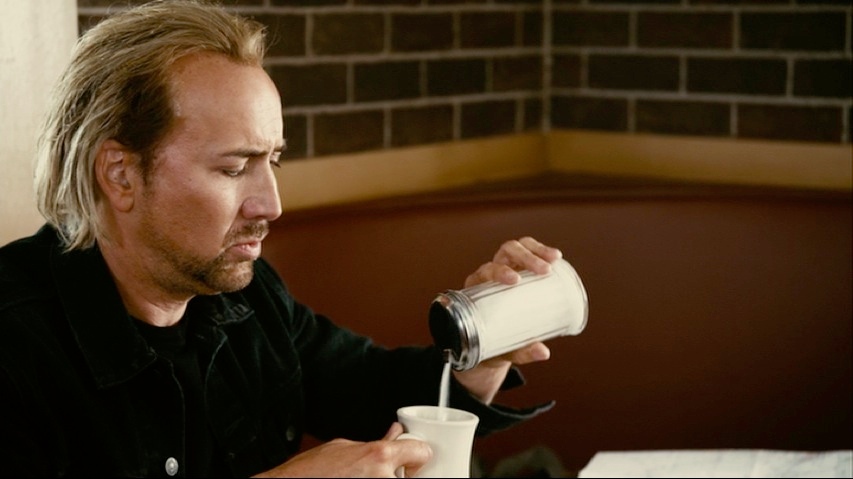
Nicolas Cage in Drive Angry (Patrick Lussier - 2011)
Posted by Peter Nellhaus at 09:54 AM
November 07, 2014
Iceman

Bing Fung: Chung Sang Chi Mun
Law Wing-cheung - 2014
Well Go USA Region 1 DVD
Would I have liked Iceman a bit more had I not seen the original version? Maybe. Would I have liked Iceman more had I seen it in 3D as did the audience in China? Maybe. But I did see the film from 1989, with the English language title of The Iceman Cometh (and, no, Eugene O'Neill had nothing to do with Clarence Fok's film other than the title).
The story about a frozen Ming Dynasty guard, discovered, and accidentally defrosted in contemporary Hong Kong, was sort of interesting. The real reason for watching Fok's film is to see that martial arts fantasy stolen by Maggie Cheung as the ditzy prostitute who takes the befuddled stranger from another century reluctantly under her wing. Cheung's underused comic chops are on display here, especially in one laugh out loud scene where she fakes an orgasm while with a client, sneaking a glance at her watch. For those unfamiliar with his earlier film, the much respected critic, Jonathan Rosenbaum, includes The Iceman Cometh as one of his one thousand favorite films, primarily for Maggie Cheung's performance.
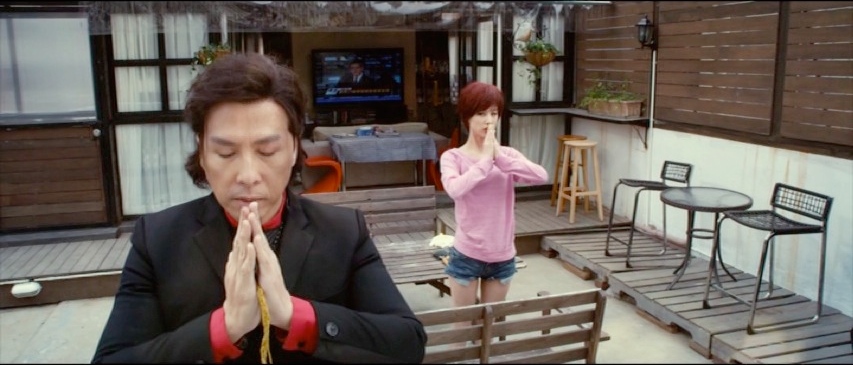
As the "Making of . . ." supplements makes abundantly clear, this new version is definitely Donnie Yen's joint, even if Law Wing-cheung is the credited director. Unlike the earlier version, there is nothing and no one to distract from Yen as the most important character here, even with the heavy duty support of Simon Yam, Lam Suet and (the very popular in China) Wang Baoqiang. Eva Huang won't make anyone forget Maggie Cheung, and is seen here as a bar hostess who takes Yen's character for a ride financially when she discovers the value of the little gold pieces he carries in his pocket, but really has a heart of gold in caring for her aging mother.
The major mistake of this new version is that the character of Ying, waking up after a nearly four hundred year sleep, too quickly adapts to his new environment. There is a scene with Ying drinking out of a toilet bowl, one of several scenes of bathroom humor, but it is hard to believe that someone from the past would figure out how to use an internet search on a tablet within days such a radical shift in environment. Funnier is when Wang, as a rival Ming Dynasty guard also frozen in the same avalanche, uses his first pistol, and a more effective means of being a killer.
Much of the film is given over to special effects, making the most of the 3D effects. There is a lot of wire work, with Yen uncharacteristically making high leaps across buildings, lampposts and buses. There is also an elaborate chase of cars and people on one of Hong Kong's busiest bridges, actually shot on a life size reproduction. And as admirable as it is that having past the age of fifty, Donnie Yen is still making films that display his martial arts chops, his character of Ying is barely two-dimensional in this 3D extravaganza.
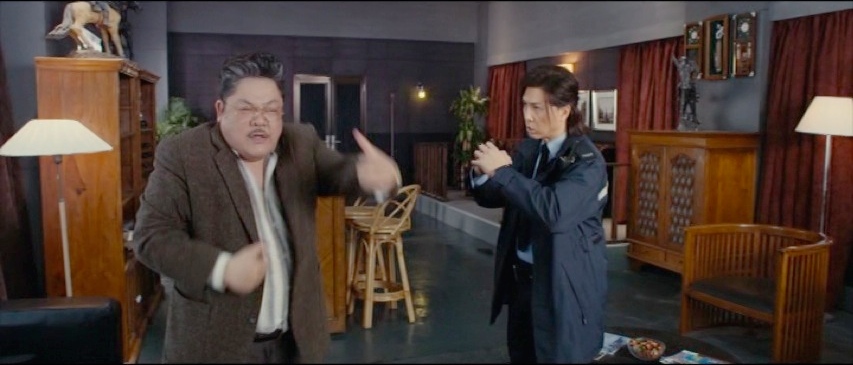
Posted by Peter Nellhaus at 07:16 AM
November 05, 2014
Dormant Beauty

Bella Addormentata
Marco Bellochio - 2012
Kino Lorber Region 1 DVD
It was purely coincidence that I would be seeing Dormant Beauty at the same time that Brittany Maynard's medically assisted suicide would be in the news. The closest in recent memory that the debate over the right to die made serious headlines in the United States was in the case of Karen Ann Quinlan, who remained in a coma for ten years. Marco Bellochio's film is about a more recent even in Italy, 2009, taking place during the last days of Eluano Englaro, in a coma for seventeen years, in a case that involved the government trying to intercede on behalf of the Vatican.
For Bellochio, the personal is almost always political, and vice versa. The film has four parallel stories, two of which are more directly connected to Englaro. A senator, dealing with his dying wife's request to not continue life with artificial support, has a crisis of conscious when deciding to maintain his political career by voting against the right to die along with the rest of his party. His daughter, Maria, has joined the protest against euthanasia, traveling to Udine, where Englaro spent her last days. At a rest stop restaurant, Maria and her friends encounter two brothers who are also traveling to Udine, in join the right to die supporters. Overhearing the conversation of the girls to bring water to Englaro, the younger brother splashes his glass of water in Maria's face. The older brother, Roberto, takes out his handkerchief, tenderly drying off Maria's face. It's love at first sight, even though Maria and Roberto haven't quite figured that out yet.

In the other stories, a young doctor tends to a suicidal young woman, a drug addict who sees no point in living, and a mother, a famed actress, keeps alive her comatose daughter at the expense of her relationship with her son and husband.
In an interview, Bellochio discusses how the title could have just as well been translated to English as "Sleeping Beauty". Probably to do so would have caused a misunderstanding with audience expectations. Further, the title could well refer to Englaro, seen briefly in a photograph on a news show, as well as the daughter of the actress, the drug addict, and the senator's wife.
Unlike the last film by Marco Bellochio, Vincere, with its more immediately recognizable subject matter of the rise of Mussolini, Dormant Beauty has received a less heralded stateside release. This might not be surprising as it took me some time to do some quick online research to get a clearer idea of the context, particularly in regards to the narrative strands for the senator and his daughter.
Even without understanding all of the political and cultural strands, there are several moments worth savoring - Alba Rohrwacher and Michele Riondino as Maria and Roberto, having a spontaneous tryst, with Maria quickly moving the crucifix around her neck backwards, Isabelle Huppert as the actress, reciting the famed lines from Lady Macbeth in her sleep, and Maya Sansa, who won as Italy's Best Supporting actress, as the addict squaring off against the doctor.
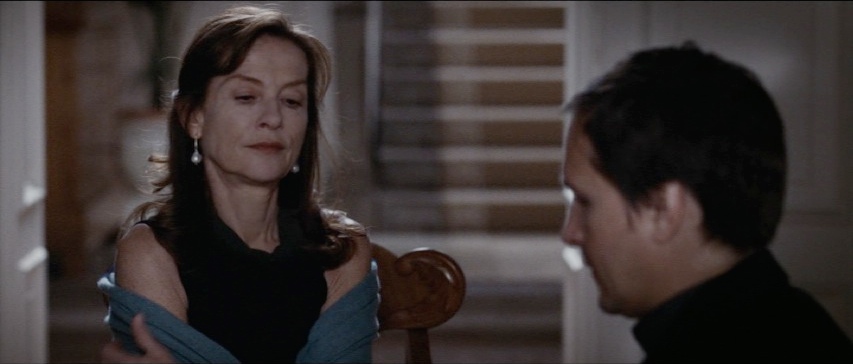
Posted by Peter Nellhaus at 06:36 AM
November 03, 2014
Lamberto Bava's Demons
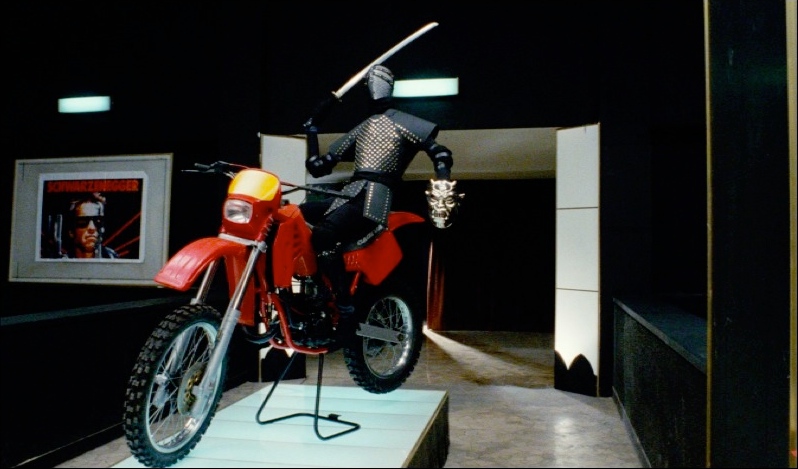
Demons / Demoni
Lamberto Bava - 1985

Demons 2 / Demoni 2 . . . l'incubo ritorna
Lamberto Bava - 1986
both Synapse Films Region 1 DVD
I have had a recurring dream that I recall twice, each time taking place in a different location, but the same story. I am wandering in nature, a path in the foothills or a desert region. Tucked away where there a no other buildings is a movie theater. The movie is something so rare, so difficult to see, and might possibly be a film by an esteemed director that doesn't actually exist. I wake up convinced that I had actually been to this movie theater in my dreams, although I the closest I get to watching a movie is the sound from the lobby.
I thought about that dream because Demons is suppose to take place in a theater that supposedly no one knew existed. That "Metropol" theater is pretty hard to miss. Maybe more difficult to believe is that a theater showing a free movie wouldn't be packed to the rafters, even if the tickets are being given out by a tall guy with metal pieces covering parts of his face. The theater is kind of snazzy, with posters for Metropolis, Four Flies on Gray Velvet and, um, No Nukes, and there's a motorcycle and a samurai sword exhibited in the middle of the floor for no particular reason other than to be used later in the movie. Even though the rules of exhibiting memorabilia are that you look but don't touch, it doesn't stop one woman from temporarily donning a gold mask with the face of a demon. No sooner that you can yell, Onibaba, the woman finds herself with a small bloody cut.
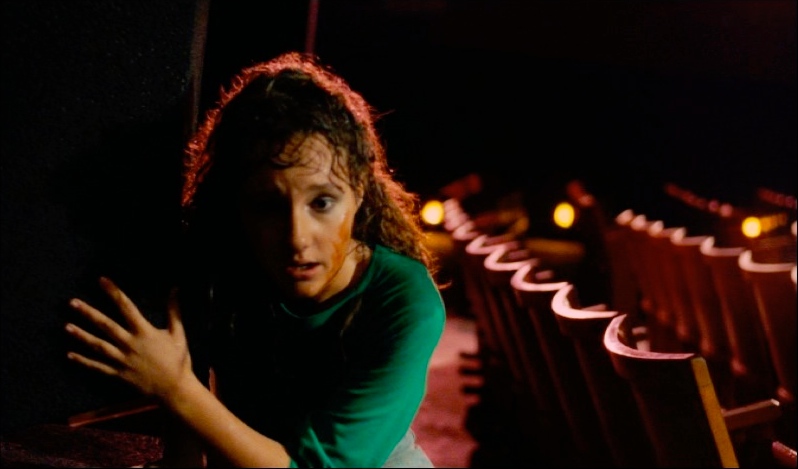
While the woman is in the bathroom, turning into some kind of demon with sharp teeth, frothing green foam from her mouth, the audience is watching a horror movie where some dumb teens find the grave of Nostradamus and of course have to open it. There is cutting between the demons in the theater and the demons on screen until the story concentrates on the kids trapped in the theater.
There are a couple of moments of visual wit going on here. The opening shot is if the headlights of a bus in the dark. That shot is almost duplicated in the film within the film, where the two headlights turn out to belong to two motorcycles. The demons' eyes light up in the dark like headlights as well. The opening scene on the bus nicely sets up the sense of disorientation experienced by the character, Cheryl, both a sense of uncertainty where she is traveling as well as in a seemingly deserted station. There is also one very funny visual joke involving coke and Coke.
Like the first film, Demons 2 bogs down to a humans versus demons battle, with most of the best scenes taking place in the first twenty minutes or so. The film begins with some visual humor when we see the explanation for what appears to be a very bloody knife. The narrative alternates between residents of a high rise apartment building, several whom are watching the same television show about demons. The television show is suppose to be a documentary, but it looks more like actors similar to those of the first film, trespassing on a grave where a demon is buried. One of the residents is played by ten year old Asia Argento, cute, but hardly giving evidence that she would grow up to be a respected filmmaker and prize winning actress. There is also a youngish woman named Sally, having a birthday, who would rather watch television than show up at her own party. Somehow, the televised demon pops out of the TV set, and turns Sally into a demon. Sally would rather chew on her guests than the specially prepared birthday cake.

The television show of the demon hunters features a moment that pays homage to Lamberto's father, Mario Bava. The photographer of the crew accidentally cuts herself. Some blood drips on the dead demon, bringing him back to life. The scene is lifted from the elder Bava's Black Sunday, when the vampire played by Barbara Steele is brought back to life in similar fashion. Shots of demon Sally, running in slow motion towards the camera, against a cyclorama depicting dawn, has a dreamlike quality also reminiscent of Mario Bava.
Both DVDs are gorgeous looking, and the image and sound are probably better than when the films first appeared at local multiplexes. If Demons 2 has the edge for me, it is because of the very nice establishing scenes of the apartment residents, divided by walls, but all watching the same television show, as well as scenes with a little, shaggy terrier becoming a demon dog, and the emergence of a flying baby demon. With four screenwriters, including producer Dario Argento, on both films, one would wish that there would have been a few more inspired moments to carry the nuttiness from beginning to the final fade out. To get an idea of what the Demon films could have been, had the filmmakers been more unhinged, I would encourage those who haven't seen it, to check out the Thai horror comedy SARS War. Both films take place in a high rise, as well as sharing flying baby monsters. Sometimes you have to take the ridiculous to extremes in order to be sublime.

Posted by Peter Nellhaus at 09:35 AM